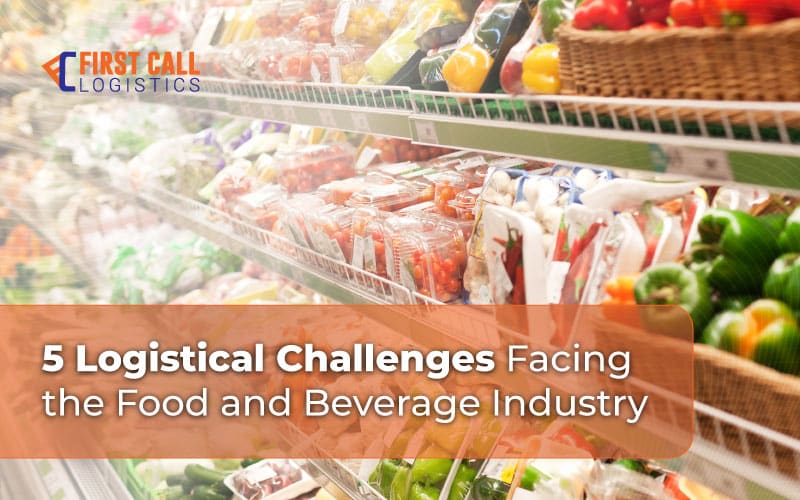5 Logistical Challenges Facing the Food and Beverage Industry

These buzzy marketing terms within the food and beverage vertical are evidence of growing consumer demand for freshness in their perishable products. And while the so-called “fresh fever” is currently strongest in the northeastern U.S., the rest of the country isn’t far behind.
Maintaining a product’s optimal freshness is no simple task, and rising pressure to provide quicker order turnarounds and faster deliveries are giving even the most experienced logisticians a run for their money.
Let’s take a closer look at the top five transportation issues challenging the food and beverage supply chain today.
1. Narrow Delivery Windows and Hidden Fees
With the growing demand for shipping services worldwide, distribution centers are working around the clock to ensure incoming shipments are unloaded, processed, prepped and on the road for delivery with maximum efficiency. To help manage the influx of shipments, freight is assigned a Must Arrive by Date (MABD) — if the delivery window is missed, the supplier is charged a fee to cover the costs of rescheduling and the resulting inconvenience of processing the shipment at a different time.
These penalty fees are known as chargebacks, and they’re not just limited to late deliveries. A supplier could be issued a chargeback for mislabeled products, incorrectly palletized freight, missing documentation and other behaviors the receiver wishes to discourage because they impede efficiency — and of course, every distribution center and retailer has its own operational standards.
Chargebacks can be especially impactful on LTL shipments, which make multiple stops to deliver portions of the trailer’s cargo — if one stop is late or delayed, it pushes all other deliveries off-schedule too.
2. Limited Refrigerated Vehicle Availability
Many perishable food and beverage items need to be shipped using temperature-controlled transportation to prevent spoiling. However, the supply of available refrigerated vehicles isn’t growing nearly as fast as the demand (mostly due to the high costs associated with owning and operating this type of equipment).
The result is a much tighter capacity, especially during peak produce season from April to July when refrigerated trucks become even more scarce. High demand also means higher shipping rates compared to regular truckload and dry van shipping rates. Higher shipping costs inevitably filter down the supply chain to consumers, increasing the shelf price of products.
3. Potential Product Damage Due to Increased Handling
Food and beverage items are required to meet several federal regulations designed to ensure safe handling throughout the shipping process. The Food Safety Modernization Act (FSMA) includes a mandate to thoroughly clean trucks and trailers between loads to reduce the risk of contamination — odors and other signs of lingering contamination must be completely removed from the trailer to avoid permeating the next load’s packaging and ruining the shipment.
Repeatedly loading and unloading goods during transport — particularly LTL shipments — naturally increases the risk of damaged products. Snack and bulk items are especially prone to damage, as bags and totes tend to be more fragile and prone to ripping. There’s also a greater risk of cross-contamination anytime different kinds of products share a trailer, as is the case with LTL shipments.
4. Shipping Smaller Loads More Frequently Is Raising Costs
In order to meet the public demand (and federal guidelines) for freshness, food and beverage products generally need to move quickly to avoid sitting for long periods and risking spoilage. However, since food and beverage shipments don’t often fill entire trailers these products are commonly moved via LTL shipping.
Frequently, LTL freight is picked up by local drivers and delivered to a central hub or regional facility where shipments are organized by destination and loaded up again for delivery — all that extra unloading/loading introduces additional moving parts to the food and beverage supply chain, increasing risk to the product (see above) and overall operating costs.
5. Changing Markets are Making Shipping Costs Unpredictable
A final challenge within the food and beverage industry is the supply chain’s susceptibility to price fluctuations due to current market trends and margin compression. Suppliers can’t not ship their products for fear of missing the peak freshness window, so they’re forced to pay the current market price —- with little room to negotiate.
Today’s consumers are willing to pay more for fresher products, but the day may come when the market raises costs so high that consumers don’t find them worth paying. Though we have yet to hit this critical tipping point, supply chain experts are looking for creative solutions to ship perishables faster and more safely with fewer out-of-pocket costs for suppliers.
Enlist Industry Experts to Help Solve Your Logistics Problems
If you’re struggling with these transportation challenges or any other logistical problems, consider enlisting a team of logistics experts to help. A reliable 3PL partner can optimize your supply chain to reduce chargebacks, use their established carrier network to secure the lowest shipping rates and strengthen your supply chain against market disruptions.
Contact First Call today for expert help with all of your logistical needs!
Simplify your Next Shipment with First Call Logistics
More Resources for FCL Shippers:
Get the latest supply chain news and updates directly to your inbox.